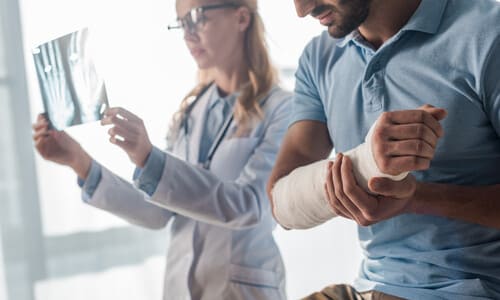 Do I need a Hartford Car Accident Broken Bone Lawyer?
Do I need a Hartford Car Accident Broken Bone Lawyer?Broken bones are never an easy thing to deal with. Even the simplest of fractures can cause immense pain, and the smallest of cracks can be weaknesses that lead to breaks when sufficient force is applied.
And rarely is the human body exposed to forces as strenuous and dangerous as those present during a serious car accident. Twisted metal and several tons of carbon fiber, glass, and steel can easily bend, snap, and even crush bone.
These levels of physical stress can easily end a person’s life, but just because a person survives such a traumatic event doesn’t mean their troubles end there.
Depending on the severity of the injuries, a car accident victim’s day-to-day can turn into a lifetime of pain spent adapting to acquired disabilities. Paralysis is common, as motor vehicle accidents have historically been a leading cause of broken backs and, thus, spinal cord injuries in the US.
Besides paralysis, the most serious of broken bone injuries can end in disfigurements and amputations. There is hope, however, in the fact that when treated, most broken bone injuries heal.
The only problem is getting the money to get the treatment you need. To this end, Bert McDowell Injury Law recommends you turn to one of our Hartford car accident broken bone lawyers.
When you work with a Hartford car accident broken bone lawyer from Bert McDowell Injury Law, you gain a representative who prioritizes your rights throughout your struggle for fair compensation. You gain an asset who can ensure your interests are protected.
Here is what they can do for you:
That’s not all an attorney can offer you, but this summary gives you an idea of the advantages you can secure for yourself when you are in need of recovery after a serious car accident.
Broken bone injuries, more commonly known as fractures, are categorized in different ways depending on the characteristics of the damage. As such, each injury can be considered a different type under each of these categories.
Most commonly, fractures are classified based on skin involvement, the pattern of the break, their stability, or the mechanisms that caused them. While not an exhaustive list of all classification systems, these are the ones most often referred to.
There are two types of fractures based on skin involvement: open and closed fractures.
Open fractures are also called compound fractures. These occur when the bone pierces the skin and is exposed to the outside.
These fractures are extremely painful, as the bone penetrates multiple innervated tissues. More importantly, open fractures pose an increased risk of infection than closed fractures due to exposure to unsterile environments.
Closed fractures, on the other hand, are also called simple fractures and occur when the skin remains intact, covering the broken bone. There may still be tissue damage, such as to the muscles or other internal organs, on account of shards of the broken bone, though the risk of infection is often lower than open fractures.
This type of injury is usually less life-threatening than the former. However, there are cases where simple fractures can be more dangerous, such as when a broken rib threatens to pierce vital organs.
There are five types of fractures according to the pattern of the break. These are greenstick, transverse, oblique, spiral, and comminuted fractures.
Stability in terms of broken bone injuries means the position of the ends of the bone. This system categorizes fractures as either stable or displaced.
Stable fractures are ones where the ends of the bone are still aligned with each other, with little to no significant movement. This allows for easier healing and less medical intervention, occasionally allowing injuries as serious as comminuted fractures a better chance of total recovery.
Displaced fractures, on the other hand, are characterized by misaligned bones that have moved out of place. As one would expect, these take a greater degree of intervention to properly heal than stable fractures.
This classification describes the current state of the injury. A currently displaced fracture can stabilize and vice versa, such as during transportation to a medical facility.
The application of force that causes an injury can also be used to classify fractures. Avulsion, compression, and stress fractures, for example, are specific types of broken bone injuries that all give an impression of how the damage was sustained.
When you’ve sustained broken bones from a car accident, call Bert McDowell Injury Law. Attorney Bert McDowell is a proven lead lawyer with a penchant for hard work and a seasoned veteran in personal injury claims, and we are here to fight for you.
Our experience in car accident cases allows us to provide the Hartford community with excellent, client-centric service. Since our founding, we have secured tens of millions of dollars for our clients, and we continue to take pride in doing so today.
Contact us today and get started on your journey to recovery with a free case evaluation. Call us at (203) 633-7449 and Bring On Bert!